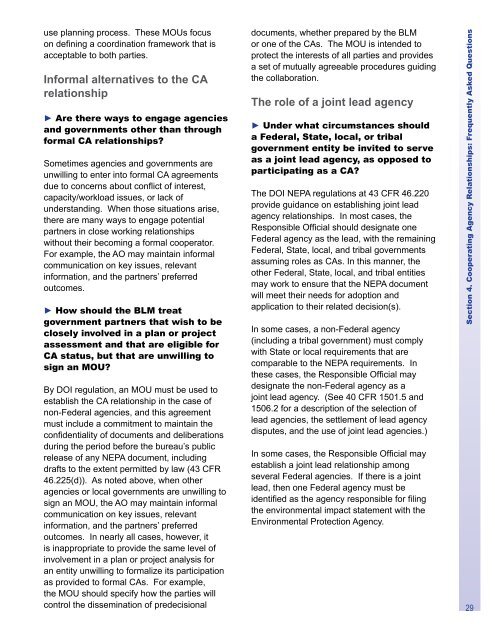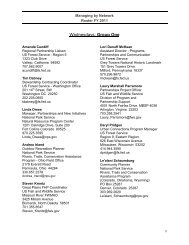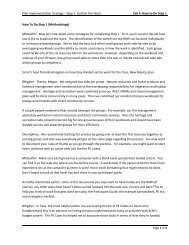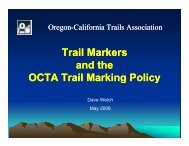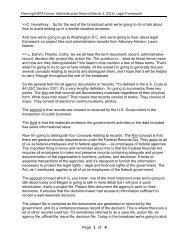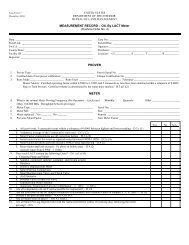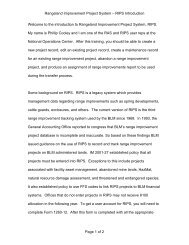BLM Desk Guide to Cooperating Agency Relationships - National ...
BLM Desk Guide to Cooperating Agency Relationships - National ...
BLM Desk Guide to Cooperating Agency Relationships - National ...
- No tags were found...
Create successful ePaper yourself
Turn your PDF publications into a flip-book with our unique Google optimized e-Paper software.
use planning process. These MOUs focuson defi ning a coordination framework that isacceptable <strong>to</strong> both parties.Informal alternatives <strong>to</strong> the CArelationship► Are there ways <strong>to</strong> engage agenciesand governments other than throughformal CA relationships?Sometimes agencies and governments areunwilling <strong>to</strong> enter in<strong>to</strong> formal CA agreementsdue <strong>to</strong> concerns about confl ict of interest,capacity/workload issues, or lack ofunderstanding. When those situations arise,there are many ways <strong>to</strong> engage potentialpartners in close working relationshipswithout their becoming a formal coopera<strong>to</strong>r.For example, the AO may maintain informalcommunication on key issues, relevantinformation, and the partners’ preferredoutcomes.► How should the <strong>BLM</strong> treatgovernment partners that wish <strong>to</strong> beclosely involved in a plan or projectassessment and that are eligible forCA status, but that are unwilling <strong>to</strong>sign an MOU?By DOI regulation, an MOU must be used <strong>to</strong>establish the CA relationship in the case ofnon-Federal agencies, and this agreementmust include a commitment <strong>to</strong> maintain theconfi dentiality of documents and deliberationsduring the period before the bureau’s publicrelease of any NEPA document, includingdrafts <strong>to</strong> the extent permitted by law (43 CFR46.225(d)). As noted above, when otheragencies or local governments are unwilling <strong>to</strong>sign an MOU, the AO may maintain informalcommunication on key issues, relevantinformation, and the partners’ preferredoutcomes. In nearly all cases, however, itis inappropriate <strong>to</strong> provide the same level ofinvolvement in a plan or project analysis foran entity unwilling <strong>to</strong> formalize its participationas provided <strong>to</strong> formal CAs. For example,the MOU should specify how the parties willcontrol the dissemination of predecisionaldocuments, whether prepared by the <strong>BLM</strong>or one of the CAs. The MOU is intended <strong>to</strong>protect the interests of all parties and providesa set of mutually agreeable procedures guidingthe collaboration.The role of a joint lead agency► Under what circumstances shoulda Federal, State, local, or tribalgovernment entity be invited <strong>to</strong> serveas a joint lead agency, as opposed <strong>to</strong>participating as a CA?The DOI NEPA regulations at 43 CFR 46.220provide guidance on establishing joint leadagency relationships. In most cases, theResponsible Offi cial should designate oneFederal agency as the lead, with the remainingFederal, State, local, and tribal governmentsassuming roles as CAs. In this manner, theother Federal, State, local, and tribal entitiesmay work <strong>to</strong> ensure that the NEPA documentwill meet their needs for adoption andapplication <strong>to</strong> their related decision(s).In some cases, a non-Federal agency(including a tribal government) must complywith State or local requirements that arecomparable <strong>to</strong> the NEPA requirements. Inthese cases, the Responsible Offi cial maydesignate the non-Federal agency as ajoint lead agency. (See 40 CFR 1501.5 and1506.2 for a description of the selection oflead agencies, the settlement of lead agencydisputes, and the use of joint lead agencies.)In some cases, the Responsible Offi cial mayestablish a joint lead relationship amongseveral Federal agencies. If there is a jointlead, then one Federal agency must beidentifi ed as the agency responsible for fi lingthe environmental impact statement with theEnvironmental Protection <strong>Agency</strong>.Section 4. <strong>Cooperating</strong> <strong>Agency</strong> <strong>Relationships</strong>: Frequently Asked Questions29


